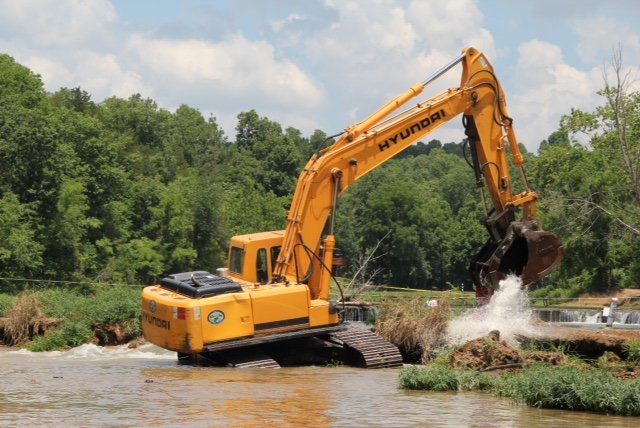A sinkhole that killed one person when it opened last month in the Spring River in northern Arkansas was closed Thursday, the commissioner of state lands said.
A team of officials used a track hoe, or excavator, to collapse the limestone roof of the sinkhole, according to John Thurston. The structure fell into itself, eliminating the possibility of whirlpools and other water hazards.
Donald Wright, who worked as executive director of the halfway house Life Recovery Center in Searcy, was floating in an area known as Dead Man's Curve below Saddler Falls on June 9 when the sinkhole opened. His kayak capsized, and the 64-year-old was sucked into the resulting whirlpool.
The sinkhole repair came about three weeks after officials from several agencies began an evaluation of the riverbed. A consulting hydrogeologist from Missouri used a dye-tracing technique to identify characteristics of the sinkhole, specifically where the water running into the cavity was exiting, Arkansas Game and Fish spokesman Keith Stephens said.
The results showed that the water was not reappearing downriver, indicating that the sinkhole was not part of a larger cave system beneath the surface, said Bill Prior, a geologist at the Arkansas Geological Survey. As a result, the sinkhole could be closed fairly quickly and easily at the site, he said.
"It was just a matter of moving some rocks around," Prior said. "We tried to help the river do what it was meant to do. We just sped it up a little bit."
Officials removed the barricades around the sinkhole, and the area is open. Prior said that people floating the river just after the repair sailed through the area without any problems.
He added that geologists will return to the site sometime next week to make sure the holes are collapsed and that rock fragments aren't posing a risk to floaters.
The Arkansas Game and Fish Commission, the Arkansas Geological Survey, the Department of Transportation, the Department of Parks and Tourism, the attorney general's office, the Fulton County sheriff's office and several volunteers assisted in the effort, which took about 30 minutes, according to a release from the commissioner's office.
“Without the tireless work of many people, we would not have completed this project in a timely manner,” Thurston said in the release. “Each agency, official and volunteer has given a great amount of time to put together the plan and act upon it before anyone else was injured.”
